So my wife and I decided to leave the humidity of Baton Rouge and visit Santa Fe, New Mexico, which bills itself as “The City Different.” Now, coming from Louisiana, we know different. We’re the state that puts seafood in everything, elects colorful politicians, and considers drive-through daiquiri shops a public service. But Santa Fe? Santa Fe is different in a completely different way, which is different from our kind of different, if you follow.
Santa Fe is the oldest capital city in the country, established in 1607—making it older than jambalaya, which is saying something. The city has been the capital of Spain, Mexico, and now the United States, giving it more government changes than Louisiana has had since Huey Long, and that’s impressive.
Adobe Instead of Shotgun Houses
The first thing you notice about Santa Fe is that every building looks like it was constructed by someone who’d never seen a proper Louisiana shotgun house. Everything is made of adobe, which is basically fancy mud. Now, in Baton Rouge, when we build something out of mud, we call it “flood damage.” But in Santa Fe, they call it “architectural heritage.”
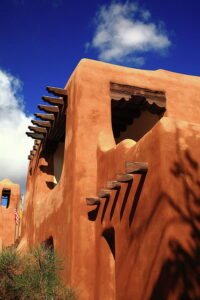
These Pueblo-style adobe buildings have been standing since 1610, which means they’ve survived longer than most Louisiana politicians’ careers and without requiring constant hurricane repairs. The adobe aesthetic is so mandatory that I’m pretty sure there’s a law against building anything that doesn’t look like a sand castle. Even their McDonald’s looks like it was designed by ancient Pueblo architects, which explains why you can’t get a proper po-boy there.
Art Galleries Instead of Seafood Markets
Where Baton Rouge has Tony’s Seafood and fresh crawfish by the pound, Santa Fe has more art galleries per square foot than we have boudin shops—and that’s really saying something. Artists started migrating here in the late 1800s, probably because they heard there was no humidity and you didn’t have to worry about your watercolors getting rained on during afternoon thunderstorms.
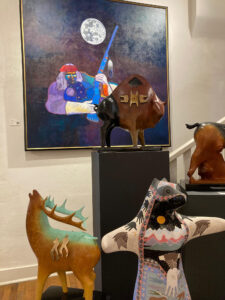
You’ll find everything from traditional Native American pottery (beautiful, but you can’t boil crawfish in it) to contemporary installations that make about as much sense as putting pineapple in gumbo. Every gallery owner will gladly explain why their sculpture of a coyote howling at a chile pepper represents the spiritual awakening of the American Southwest, which is roughly equivalent to us explaining why the roux has to be the color of a paper bag.
The Miraculous Staircase (More Reliable Than I-10 Construction)
One of Santa Fe’s most famous attractions is the “Miraculous Staircase” at the Loretto Chapel. Legend says that in 1878, the nuns prayed for nine days for someone to build them a staircase, and a mysterious carpenter appeared, built a perfect spiral staircase with no visible support, then vanished without payment.
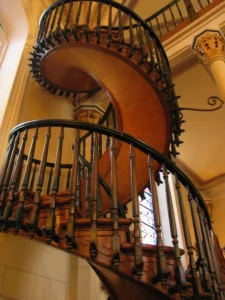
This is either a genuine miracle or the first documented case of a contractor actually finishing a job and then disappearing, which, let’s be honest, would be miraculous. Either way, this staircase has been holding up since 1878 without any visible support, making it more structurally sound than the Huey P. Long Bridge during rush hour.
Green Chile: Their Equivalent of Our Trinity
In New Mexico, they put green chile on everything. Pizza, hamburgers, ice cream—if it exists, someone has figured out how to add green chile. Sound familiar? It’s like our holy trinity of onions, celery, and bell peppers, except spicier and more obsessive. They have the same passionate debates about New Mexico versus Colorado green chile that we have about whether gumbo should have okra or filé (the answer is both, depending on your grandmother).
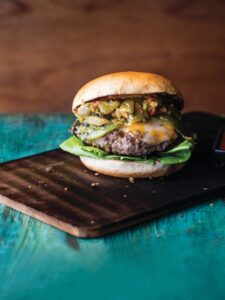
I saw green chile mac and cheese, green chile cheeseburgers, and green chile ice cream. The only thing I didn’t see was green chile daiquiris, but I suspect that’s only because they haven’t figured out the drive-through logistics yet.
Skiing in the Desert (Because Physics Is Just a Suggestion)
Ski Santa Fe gets about 225 inches of snow annually, which seems impossible considering that most of the time, Santa Fe looks like the moon, only with better Mexican food. This is like saying you can water ski on the Mississippi River in August—technically possible, but you’re gonna need a lot of faith and possibly some divine intervention.
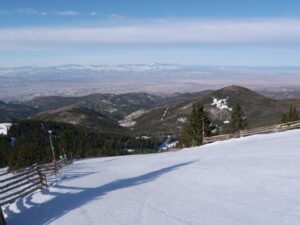
The ski area exists at an elevation where normal weather rules apparently don’t apply, much like how normal political rules don’t apply in Louisiana.
Shopping for Your Inner Spiritual Warrior (No Mardi Gras Beads Required)
Canyon Road is Santa Fe’s main shopping strip, where you can buy authentic Native American jewelry, dream catchers (provenance questionable), and crystals that will allegedly fix everything from your chakras to your transmission. It’s like the French Market, except instead of pralines and beignets, you get healing stones and sage bundles.
Every shop clerk looks like they’ve just returned from a vision quest and can explain the spiritual significance of turquoise while running your credit card. It’s very different from our approach in Louisiana, where we achieve spiritual enlightenment through really good gumbo and excellent jazz.
The Altitude Adjustment (Worse Than August Humidity)
Santa Fe sits at 7,199 feet above sea level. For those of us accustomed to Baton Rouge’s sea-level comfort (and 91% humidity summers), this means spending your first day feeling like you’re breathing through a coffee filter. The locals call this “altitude adjustment,” which is their polite way of saying “welcome to feeling like you’ve been hit by a truck.”
It’s the opposite of our climate challenges. Instead of feeling like you’re breathing underwater in a sauna, you feel like you’re breathing on Mars in a freezer.
Mexican Food (But Not Our Kind)
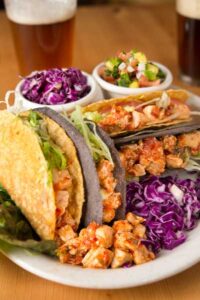
Santa Fe has amazing Mexican food, but don’t expect anything like what you’d get on Government Street or at your favorite hole-in-the-wall taqueria back home. Their idea of spicy is green chile, which is admittedly hot, but it’s a different kind of heat than our cayenne-and-Crystal-hot-sauce heat. It’s like comparing a brass band to a mariachi band—both are music, both are loud, but they’re completely different experiences.
Final Verdict
Santa Fe is indeed “The City Different,” and coming from Louisiana—a state that considers alligators acceptable lawn ornaments and snow days a valid reason to shut down civilization—that’s saying something.
But here’s the surprising thing: despite being the opposite of everything we’re used to (dry instead of humid, mountains instead of flat, adobe instead of wood, elevation instead of sea level), Santa Fe is genuinely charming. It’s got culture, history, great food, and art, just like we do, but wrapped up in a completely different package.
It’s like discovering that people in another part of the world also love music, food, and celebrations, but they do it with different instruments, different spices, and different colored buildings.
Just remember to pack your inhaler for the altitude, and don’t expect to find a decent po-boy anywhere. Some things are just too Louisiana to travel.
